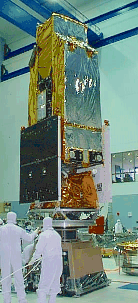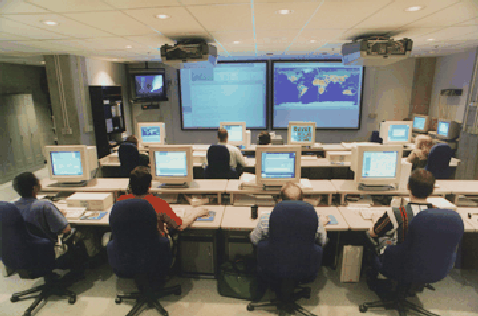|
|||||||||||||||||||
|
|
|||||||||||||||||||
|
|

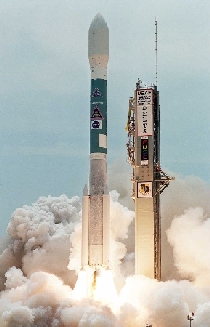 |
What was the FUSE Project?
For hundreds of years astronomers observed the Universe using only the visible light our eyes can see. However, visible light is a tiny portion of a much broader range of light energy known as the electromagnetic spectrum, which includes everything from energetic X-rays and gamma rays to infrared radiation and radio waves. Much of this "invisible" light gets blocked by the Earth's atmosphere, but since the late-1960's astronomers have been using telescopes above the atmosphere to obtain entirely different perspectives on the Universe. A new perspective, one that has only been glimpsed a few times before, was provided by a telescope known as the Far Ultraviolet Spectroscopic Explorer, or FUSE. Funded by NASA as part of what was called its Origins program, FUSE was launched into orbit aboard a Delta II rocket on June 24, 1999 for a nominal three years of science operations. In reality, FUSE lasted over eight years on orbit, before finally succombing to pointing system failures that made it unable to perform pointed science operations. The satellite was decommissioned on October 18, 2007, and is no longer active, although it may take decades before its orbit decays and it re-enters earth's atmosphere and burns up.
FUSE was developed and operated for NASA by the Johns Hopkins University. FUSE was developed in collaboration with the space agencies of Canada and France, who shared in the observing time over the first three years. This is the first time that a mission of this scope was developed and operated entirely by a university.
FUSE was designed for a very specialized and unique task that is complementary to other NASA missions. FUSE looked at light in the far ultraviolet portion of the electromagnetic spectrum (approximately 90 to 120 nanometers), which is unobservable with other telescopes. FUSE observed these wavelengths with much greater sensitivity and resolving power than previous instruments used to study light in this wavelength range.
The FUSE satellite consisted of two primary sections, the spacecraft and the science instrument. The spacecraft contained all of the elements necessary for powering and pointing the satellite: the attitude control system, the solar panels, communications electronics, and antennas. The science instrument collected the light of distant objects and contained the equipment necessary to disperse and record the light: the telescope mirrors, the spectrograph (and its electronic detectors), and an electronic guide camera called the Fine Error Sensor (or FES). The spacecraft and the science instrument each had their own computers, which together coordinated the activities of the satellite.
Astronomers viewed the Universe in a whole new light using the unique data obtained with FUSE. In particular, they sought answers to long-standing questions such as: "What were the conditions like in the first few minutes after the Big Bang?" ,"How are the chemical elements dispersed throughout galaxies, and how does this affect the way galaxies evolve?", and "What are the properties of the interstellar gas clouds out of which stars and solar systems form?" All of these questions, and many others, can be addressed by observing the far ultraviolet light from stars, interstellar gas, and distant galaxies with FUSE.
The scientific approach of the FUSE mission was special because a science team had been charged by NASA with providing answers, or at least partial answers, to intriguing questions like those posed above. Toward this end, the FUSE science team undertook a comprehensive study of the cosmic abundance of deuterium, a rare form of "heavy hydrogen" formed only in the Big Bang. The team also studied the hot gas content of our galaxy, the Milky Way, and its nearest neighboring galaxies, the Magellanic Clouds. To conduct these large studies, the FUSE science team observed hundreds of astronomical objects, using about half of the observing time during the three-year mission. The remaining observing timein the first three years, and all of the observing time in what was called the Extended Mission, was devoted to a Guest Investigator program where NASA selected scientific investigations proposed by astronomers from around the world.
What Did FUSE Explore?
FUSE was selected by NASA based on a proposal to perform several specific high-profile science goals. However, over time the mission developed into a much broader, general purpose observatory that carried out hundreds of investigations for scientists all over the world. Many of these science projects were not even conceived of at the time FUSE was being built and launched, and yet became important parts of the FUSE science legacy. FUSE investigators have published many hundreds of astronomy research papers based on FUSE observations, and we expect many more to be published in the future using the FUSE data archive.
Below, we describe briefly a couple of the initial major science goals of FUSE, but point the reader to the FUSE Science Summaries page for a representative selection of other science results.
In the infancy of the Universe, the extreme conditions present everywhere gave rise
to the creation of simple chemical elements out of which all matter was made. The
simplest element, hydrogen, consists of a positively charged nucleus containing a single
proton orbited by a negatively charged particle known as an electron. In some instances,
these hydrogen atoms also have a second particle called a neutron in the nucleus
accompanying the proton; this type of hydrogen has its own name and is called
deuterium. More complicated elements consist of atoms having larger numbers of
protons and neutrons in their nuclei
surrounded by correspondingly higher numbers of electrons.
When atomic nuclei formed in the early Universe, the conditions were so severe
that electrons were unbound to the nuclei and moved about freely. Gas with this property
is known as plasma. In this plasma, some of the hydrogen was converted to deuterium,
and some of the deuterium was converted to helium. The relative amounts of each
element produced by this nuclear fusion of protons and neutrons were very sensitive to the
temperature, density, and number of the particles in the plasma at that early time. As
the Universe expanded, the plasma cooled, the creation of elements ceased, and the free
electrons and nuclei combined to form complete atoms.
It is the sensitivity of the nuclear reactions in the primordial plasma
to the initial
conditions in the Universe that makes astronomers interested in studying the simple
elements today. By measuring the relative amounts of each element, it is possible to infer
the conditions present at a time before complete atoms existed! In particular, knowing
the ratio of deuterium atoms to hydrogen atoms left over from the Big Bang would
allow astronomers to place a strong constraint on how much observable matter there is in
the Universe.
Alas, Nature does not reveal secrets such as these easily; the abundances of
some elements have changed over time. The interior cores of stars are hot enough (tens
of billions of degrees) to mimic those conditions in the first few minutes of the Universe
and convert deuterium into helium by the addition of another proton to the deuterium nucleus.
Unlike the early Universe, however, the nuclear reactions in stars are sustained
over very long periods of time, which means that fragile light elements like deuterium can
be readily converted into much heavier elements. For this reason, astronomers believe
that the total amount of deuterium in the Universe is decreasing as matter gets cycled
through stars, but they do not know how fast it is decreasing or how much deuterium has
already been destroyed.
This is where FUSE entered the quest to understand our cosmic origins. Astronomers
used FUSE to search for deuterium in the interstellar medium near the Sun, in gas
clouds in the far reaches of the Milky Way, and even in distant intergalactic clouds between galaxies.
What researchers found was a new puzzle: the amount of deuterium (relative to normal hydrogen)
appears to vary over a much broader range of values than expected. The best current interpretation
of the FUSE results is that deuterium can be incorporated preferentially into interstellar dust
grains, giving low gas-phase abundances (what FUSE measured). In places where supernova shock waves have
heated this dustgrains, deuterium has been released back into the gaseous form where FUSE could observe it.
Thus, the highest measured values are what we should compare to
estimate how toal value to estimate how dmuch deuterium has
been destroyed since the Big Bang. This amount is significantly less than
many astronomers have assumed to be the case.
As is often the case in science, the solving of one mystery opens to door to new questions
that must be asked and understood.
Galaxies like our own are massive collections of stars, gas, and dust. Matter and
energy are exchanged between these various components in a grand cycle that changes the
chemical and physical properties of galaxies. Stars form from the interstellar material,
synthesize chemical elements in their interiors, and return their products to the interstellar
gas during their lives and in their death throes. All naturally occurring elements
heavier than lithium are produced by these cycles. The carbon atoms that form the basis of
life, the oxygen we breathe, and the silicon in the sand on our beaches were all formed
deep inside some previous generations of stars. The calcium in our teeth, the copper in
our coins, and the iron in the steel frames of our cars are formed in massive stellar
explosions called supernovae that occur as stars exhaust their nuclear fuel, collapse
under their immense weight, explode, and reseed the interstellar gas for a new generation
of stars.
The beautiful Horsehead Nebula in Orion dramatically demonstrates the presence of
gas and dust in the vast regions of space between the stars. (Image © Anglo-Australian
Observatory.)
Understanding how stars and the interstellar medium interact with each other is a
major concern of astronomers. The energy produced by stars is shared with the
interstellar medium as stellar winds sweep up gas and dust, and stellar explosions vacate large
cavities and create "bubbles" filled with very tenuous, hot gas. This stellar activity can
trigger interstellar gas clouds to collapse and form new stars and solar systems, or it
can disrupt the very same processes and prevent them from occurring.
One of the major predictions of theories for these interactions is that some portion of
the interstellar medium should be heated to very high temperatures by all this activity.
In the hot gas, atoms are ionized that is, the electrons that normally surround the
atomic nuclei are stripped off the atoms. As the gas cools, some of the electrons reattach to
the positively charged ions. One of the most important ions that astronomers can observe
is oxygen that has had five of its eight electrons removed; this form of oxygen is called
O VI ("oxygen six"). It is a very good indicator of gas that has been heated to temperatures
of one million degrees or more and is cooling as the recombining electrons and ions emit
or absorb light.
The graceful arcs of the Vela supernova remnant are seen against the rich
star field of the Milky Way. These gaseous filaments arise where the 10,000 year old
supernova blast wave has swept up and heated the tenuous interstellar gas.
(Image © Anglo-Australian Observatory.)
FUSE was designed to make very sensitive measurements of O VI in the interstellar
medium and the remnants of supernova explosions. One of the primary scientific
objectives of the FUSE mission was to determine whether a large halo of hot gas surrounds our
galaxy. By studying the distributions of O VI and many other atoms and ions,
astronomers were able to determine the composition of the interstellar gas, how well it is mixed,
and which processes have been effective in heating the gas. Not only did FUSE confirm the presence of
a hot halo of gas, but it found an even more tenuous, expended `corona' of hot gas that extends
out even further than the halo. All of this new information must now be incorporated into theoretical
models to help us understand how galaxies evolve and form new generations of stars and planets.
For more on FUSE Science:
To accomplish its task, FUSE incorporated a number of unique design features. For
instance, instead of a single mirror FUSE used
four mirror segments to reflect the light to focus. Two mirror
segments were coated with a material (silicon carbide) that
has superior reflectivity at the shortest ultraviolet wavelengths, and two mirror
segments were coated with a different material (aluminum and lithium fluoride) that reflects better at
longer wavelengths. This optimizes performance over the entire spectral range. FUSE
also used two sophisticated electronic detectors to "see" the incoming ultraviolet light
and record it digitally for downlink to the ground.
The ultraviolet light seen by FUSE was dispersed (or broken up) into a spectrum by
four special optical components called
gratings (one for the light from each of the four
mirror segments). The FUSE gratings were quite large, and were etched with a very
large number of fine, parallel grooves. The grooves dispersed the light into a spectrum, and
the large number of grooves packed closely together provided the high resolving power
(ability to see details) that allowed FUSE to do its job. The FUSE gratings were curved
instead of flat, which made their manufacture very complex and difficult.
The Fine Error Sensor (or FES) cameras were
the "eyes" of the satellite. The FES worked
in visible light, and imaged a region about a third of a degree in size in the direction that
the telescope was pointing. (For comparison, the moon is about half a degree across.) The
FES could see stars down to about 14th magnitude, which is about 5,000 to
10,000 times fainter than you can see on a typical clear night! The FES produced the only
"pictures" that came from FUSE; but the real job of FUSE was to observe the spectrum
of astronomical objects in far-ultraviolet light invisible to ground-based telescopes.
Analysis of these spectra provided a wealth of information about each object being observed
and any gas or dust along the line-of-sight that may have absorbed some of the light along the way.
FUSE was controlled through a primary
ground station antenna located at the
University of Puerto Rico, Mayaguez.
The satellite's circular 775 kilometer (480 mile)
orbit, which took about 100 minutes for a single revolution, brought it over the ground
station for less than 10 minutes at a time (on average) for about six or seven orbits in
a row, followed by roughly seven or eight orbits without contact. Hence, the satellite
had to operate on its own most
of the time, moving from target to target, identifying star fields, centering objects in
the spectrograph apertures, and performing the observations. The scientific data, which
were stored in digital form, were radioed to the ground during contacts with the ground station.
All of the instructions the satellite needed to perform its tasks were
pre-planned and uplinked to the onboard computer during contacts with the ground station.
Preparation of these instructions occurred in the
Satellite Control Center located in the Bloomberg
Center for Physics and Astronomy at The Johns Hopkins University in Baltimore, MD.
Potential observations
were scheduled based on predicted viewing intervals, spacecraft positioning constraints,
and the needs of each science program. These schedules, or timelines of activities, were
then turned into detailed instrument instructions and uplinked to the satellite by a team
of engineers. The observations normally took place without direct interaction by
ground controllers.
The first 3-1/2 years of FUSE operations were dubbed the Primary Mission.
During this period, the observing time on FUSE was shared roughly 50-50 between the
FUSE science team and a host of
Guest Investigators, astronomers from around the world selected by NASA to participate in
the FUSE program. Starting April 1, 2003, the FUSE project wntered an extended phase of
operations which lasted until mid-2007.
With funding from NASA, the FUSE satellite continued to be operated as an observatory
for the broad astronomical community, with 100% of on-orbit observing time selected by
NASA peer review. Some 29 million seconds of science data were obtained during
the Primary Mission phase, and a total of nearly 65 million seconds of data were archived
from the entire mission.
The Extended Mission period presented a number of challenges, especially for satellite operations.
Many procedures had to be automated, allowing the project to cut back on
staffing and minimize operations costs. As one example, the Satellite Control Center was staffed
around the clock during the Prime Mission, but transitioned to a 16 hour per day, Monday
through Friday staffing profile in the Extended Mission. Less redundancy and less access to
ongoing engineering support was consistent with NASA policy for missions in their extended
phase, where a higher level of risk is allowed.
Dr. Warren Moos is Professor of Physics and Astronomy at the Johns Hopkins University.
He is a specialist in space optics and ultraviolet instrumentation. In addition to
being the Principal Investigator of the FUSE mission, he was a co-investigator for the
Space Telescope Imaging Spectrograph installed on the Hubble Space Telescope in 1997 and
a co-investigator for the Hopkins Ultraviolet Telescope, flown on Space Shuttle flights
in 1990 and 1995. Dr. Moos was also a co-investigator for the Voyager UVS and the
Apollo 17 UVS experiments and has been an extensive user of space telescopes. Dr. Moos
has served previously as Director of the Center for Astrophysical Sciences and as Chair of
the Department of Physics and Astronomy at the Johns Hopkins University.
FUSE is a joint project of the
National Aeronautics and Space Administration
and the Johns Hopkins University
in collaboration with:
Centre National d'Etudes Spatiales (France),
the Canadian Space Agency,
the University of Colorado,
and the University of California, Berkeley.
Deuterium in the Local Universe

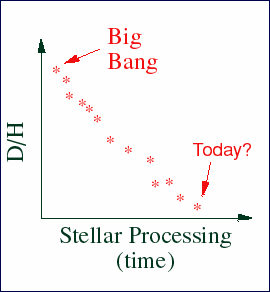
The Chemical Evolution of Galaxies
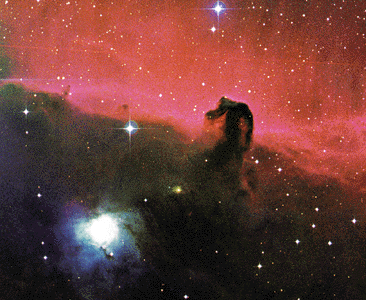
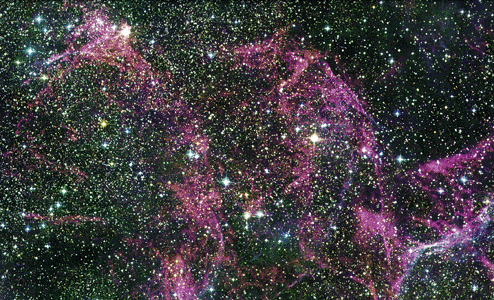
go to the FUSE Science Summaries page.
How Did FUSE Work?
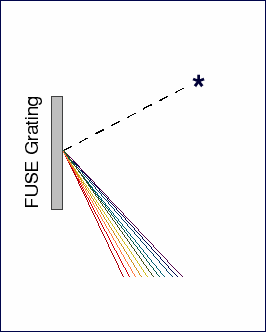
FUSE Operations
FUSE Primary and Extended Missions
FUSE's Principal Investigator

FUSE Partners
|
|
|




 Follow Us
Follow Us
